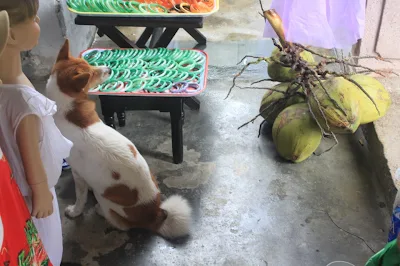A well renowned Zen master, Thich Nhat Hanh, hailed originally from this city in central Vietnam - Hue.
This hub which served as the political base of the Nguyen Dynasty from 1802 to 1945, also boasts its so-called royal cuisine, which tends to be spicy and emphasises on small servings, including the well known white rose dumplings. Hue is also located near the infamous DMZ, created after the French colonists lost the battle of Dien Bien Phu in 1954. The national dress of Vietnam, the ao dai, originated from Hue, based on royal clothing styles. Together with the Champa ruins in My Son and the nearby multicultural town of Hoi An, Hue is also a declared UNESCO heritage site, focused on the imperial Citadels, royal tombs, elephant versus tiger fighting arena and a strong underlying Confucian and Buddhist culture. It is currently the administrative capital of Tua Thien Province in Vietnam.
Above picture shows the dragon head of a boat moored on the Perfume River in the evening we arrived, and below is a detail reminiscent of China's Forbidden City in Beijing.
The Hue Citadel ( Dai Noi) has recently experienced a restoration effort, with a royal compound open to visitors (above) and an impressive facade outside, surrounded by a moat. You can see clear damaged walls from the significant fighting in the sixties between the US forces and the Vietcong. In the past, the royal families actually lived inside this area, with specific buildings dedicated for major purposes - including the Mieu temple and the Hall of Supreme Harmony. There are several gates. Hue was the capital of a previous unified Vietnam, before the recent reunification of the country in 1975 with Ha Noi as its capital.
The Thien Mu Pagoda complex in Hue sits on a hill beside the Perfume River ( Song Huong) with a large compound, including the main shrine and prayer hall, a monastery and independently standing pavilions, including one that provides the names of scholars who achieved attainment of passing Vietnam's royal examinations (held in the same spirit as the Chinese ones further up north). Such honoured names are inscribed on a tablet held by a stone turtle ( second picture below).
My group's motorbike tour also included visits to a previous American bunker area overlooking the Perfume River (picture below), which has now been re-vegetated with planted flora and used mainly now by courting couples. Above, the joss sticks with colourful handles made in a village that specialises in this handicraft.



































